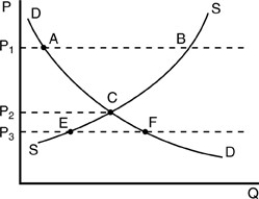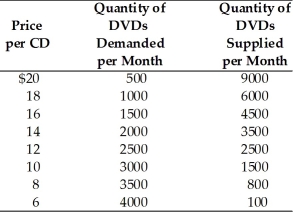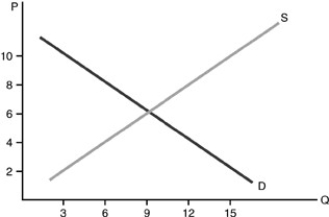A) a higher price
B) a higher income
C) expectations of future price increases
D) All of the above are correct.
F) A) and C)
Correct Answer

verified
Correct Answer
verified
Multiple Choice
A shift in the demand curve to the right represents
A) an increase in demand.
B) a decrease in demand.
C) an increase in quantity demanded.
D) a decrease in quantity demanded.
F) B) and C)
Correct Answer

verified
Correct Answer
verified
Multiple Choice
Which one of the following statements is true?
A) If the money price of a good increases, its relative price necessarily increases.
B) If the money price of a good increases, its relative price necessarily decreases.
C) The relative price of a good refers to the opportunity cost of purchasing it.
D) Rational consumers always ignore the monetary price of a good when deciding whether to buy it.
F) B) and D)
Correct Answer

verified
Correct Answer
verified
Multiple Choice
A shift in the demand curve will occur when
A) supply shifts.
B) the price of an input used to produce the good changes.
C) consumers' income changes.
D) the price of the product changes.
F) B) and D)
Correct Answer

verified
C
Correct Answer
verified
Multiple Choice
A demand schedule provides
A) the quantities of a good people are willing to sell every year.
B) the amount of a good a person wants to sell during a given time period.
C) the alternative quantities demanded for a given time period at different possible prices.
D) the amount of a good a person wants at different times of the day.
F) A) and B)
Correct Answer

verified
Correct Answer
verified
Multiple Choice
Which one of the following would cause an increase in the supply of cardboard?
A) a decrease in the demand for cardboard
B) an increase in the price of cardboard
C) an increase in taxes applied to cardboard producers
D) an improvement in the technology used to produce cardboard
F) B) and C)
Correct Answer

verified
Correct Answer
verified
Multiple Choice
A demand curve is a graphical representation of
A) consumer tastes.
B) national income.
C) the demand schedule.
D) relative prices.
F) All of the above
Correct Answer

verified
C
Correct Answer
verified
Multiple Choice
When there is a shortage, I. there is a tendency for price to increase. II) there is an excess quantity demanded.
A) I only
B) II only
C) Both I and II
D) Neither I nor II
F) B) and C)
Correct Answer

verified
Correct Answer
verified
Multiple Choice
If two goods are substitutes, then
A) an increase in the price of one causes the demand for the other to fall.
B) there is an inverse relationship between changes in the price of one good and changes in the demand for the other.
C) if the price of one good falls, the demand for the other good falls also.
D) changes in the quantity demanded of one good will not affect the demand for the other.
F) B) and C)
Correct Answer

verified
Correct Answer
verified
Multiple Choice
The quantity supplied of a particular good is the amount of the good that
A) households are willing to consume at each particular price.
B) firms will actually end up buying at a particular price during a given time period.
C) firms are willing to sell at each price during a particular time period.
D) households want firms to sell at each price during a particular time period.
F) All of the above
Correct Answer

verified
C
Correct Answer
verified
Multiple Choice
If the price of a product increases,
A) there is an increase in quantity supplied and a decrease in demand.
B) there is an increase in supply and a decrease in quantity demanded.
C) there is an increase in supply and a decrease in demand.
D) there is an increase in quantity supplied and a decrease in quantity demanded.
F) B) and D)
Correct Answer

verified
Correct Answer
verified
Multiple Choice
All of the following will affect the position of the demand curve EXCEPT
A) income.
B) taste and preference.
C) changes in expectations of future relative prices.
D) prices of resources used to produce the product.
F) B) and C)
Correct Answer

verified
Correct Answer
verified
Multiple Choice
 -According to the above figure, a shortage is shown between which two points?
-According to the above figure, a shortage is shown between which two points?
A) A and E
B) C and B
C) A and B
D) E and F
F) C) and D)
Correct Answer

verified
Correct Answer
verified
Multiple Choice
 -Refer to the above figure. Which of the following statements is true?
-Refer to the above figure. Which of the following statements is true?
A) Panel A shows a decrease in demand and Panel B shows an increase in demand.
B) Both Panels A and B show an increase in demand.
C) Panel A shows a change in demand and Panel B shows a change in quantity demanded.
D) Panel A shows a change in quantity demanded and Panel B shows a change in demand.
F) A) and B)
Correct Answer

verified
Correct Answer
verified
Multiple Choice
The law of demand states that there is
A) an inverse relationship between income and quantity demanded, ceteris paribus.
B) a direct relationship between income and quantity demanded, ceteris paribus.
C) no relationship between taste and quantity demanded, ceteris paribus.
D) an inverse relationship between price and quantity demanded, ceteris paribus.
F) B) and D)
Correct Answer

verified
Correct Answer
verified
Multiple Choice
 -According to the above table, there is an excess quantity demanded of 1500 DVDs at the price
-According to the above table, there is an excess quantity demanded of 1500 DVDs at the price
A) $14.
B) $12.
C) $10.
D) $8.
F) A) and B)
Correct Answer

verified
Correct Answer
verified
Multiple Choice
 -Refer to the above figure. At a price of $10, excess quantity supplied equals
-Refer to the above figure. At a price of $10, excess quantity supplied equals
A) 0.
B) 12.
C) 15.
D) infinity.
F) All of the above
Correct Answer

verified
Correct Answer
verified
Multiple Choice
Which of the following will cause a movement along the demand curve for shoes?
A) An increase in the price of socks
B) An increase in income
C) An increase in the price of shoes
D) All of the above
F) C) and D)
Correct Answer

verified
Correct Answer
verified
Multiple Choice
Any improvement in overall production technology that permits more output to be produced with the same level of inputs causes
A) a movement up the supply curve resulting in both a higher equilibrium price and quantity.
B) a rightward shift of the supply curve so that more is offered at each price.
C) no movement of the supply curve, but a fall in price and a decrease in quantity supplied.
D) a leftward shift of the supply curve so that less is offered for sale at each price.
F) A) and C)
Correct Answer

verified
Correct Answer
verified
Multiple Choice
If the price of oil rises, producers of oil will
A) increase the quantity of oil supplied.
B) supply less oil.
C) leave the amount of oil supplied unchanged.
D) cut the price.
F) All of the above
Correct Answer

verified
Correct Answer
verified
Showing 1 - 20 of 448
Related Exams